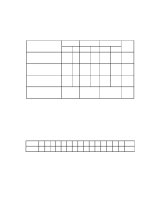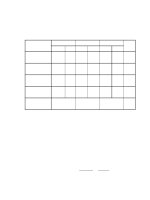de cuong hoc ki II
Bạn đang xem bản rút gọn của tài liệu. Xem và tải ngay bản đầy đủ của tài liệu tại đây (103.73 KB, 4 trang )
ĐỀ CƯƠNG ÔN TẬP
Môn tiếng anh lớp 7
(Năm học 2010-2011)
A . Cách dùng của động từ thường
1.Past simple tense
Form: S + V
(Past)
+ O
ex: I saw him yesterday. / It was a beautiful day.
2. Present simple tense
Form: S + be/V
- infinitive
+ O
egs: I am a student. I live in Noong Het.
3.Present progressive tense
Form: S + be + V
ing
+ …
egs: I am playing marble.
He is listening music.
4: Adverbs of frequency: always, usually, often, sometimes, never
eg: I always go to school on time.
5:Adverbs: too/so ; neither/ either.
* Too/ so: Use in affirmative
* neither/ either: use in negative.
Egs: A: I like beef
B: I do, Too/so do I
A: I don’t like apple
B: Neither do I/ I don’t either
B .past simple tense
Have Ss to repeat the using of past simple tense and give some Eg
Nam went to school yesterday by bus.
We played tennis 2 days ago at Lan Anh stadium .
What did you do last night ?
I did homework and watched TV.
* Used to
Form : S + Used to + Vinf……
Use: to talk about the actions what usually happen in the past.
We used to talk in the class last year
* Commands, requests and advice in reported speech
Ask Ss to give Eg
1.“Can you give me your book ?”Mr Ba said to me
Mr Ba asked me to give him my book
2.”Please do me a favor . ”Miss Nga said
Miss Nga told me to do her a favor
3.” You should get up early ”Nam said
Nam said I should get up early.
* Asking for favors
Can you help me ? /Coud you do me a favor ?
* Offfering assistance
May I help you ? /Do you need any help ?
1
C. Modal verbs
How many modals are there?
Must must not = mustn’t
Have to have not to
Ought to ought not to
Should + V-without “to” => should not (shouldn’t)
May may not
Can can not = can’t
Could could not = couldn’t
Ask students to talk about their usage. Then make some sentences
3.6. Activity 4. Adverbs of manner ( 5mins)
Give an example. I can cook very well
explain: we use the adverbs of manner after the verbs to modify them
Form: Adj + ly → Adv
Good → well
Fast → fast
Hard → hard
Love → lovely
exercise: Choose the right word in brackets to complete each sentence.
1. I tried on the shoes and they fitted me … ( perfect/perfectly)
2. He had an accident because he was driving too… (fast/fastly)
3. Do you usually feel … before examinations? (nervous/nervously)
4. Tom drove … along the narrow road (careful/carefully)
5. He look at me … when I interrupted him (angry/angrily)
+ Correct and give key their answer
1. perfectly 3. nervous 5. angrily
2. fast 4. carefully
B . thì tương lai và tương lai gần
2. Thì tương lai gần (Dùng để diễn tả hành động sẽ phải sảy ra trong tương lai)
a. câu khẳng định.
S + be + going to +V(infi ) + O
VD: I am going to go to Ha Noi next summer.
She is going to go to Ha Noi next summer.
They are going to go to Ha Noi next summer.
b. câu phủ định.(be +not)=am not ,isnot ,arenot.
S + be + not+ going to +V(infi ) + O
VD: I am not going to go to Ha Noi next summer.
She isn’t going to go to Ha Noi next summer.
They aren’t going to go to Ha Noi next summer
a. câu khẳng định.
Be + S + going to +V(infi ) + O ?
VD: Are you going to go to Ha Noi next summer?
is she going to go to Ha Noi next summer?
Are they going to go to Ha Noi next summer?
Yes, S +be
2
No, S + be not
C . so sánh hơn và hơn nhất của tính từ.
1,So sánh hơn của tính từ ngắn
+ Ta chỉ việc thêm (er) vào tính từ để so sánh hơn .
VD :tall – taller
small - smaller
-Tính từ cuối cùng la phụ âm gấp đôi phụ âm rồi thêm (er)
VD :big –bigger
hot – hotter
2, So sánh hơn nhất của tính từ ngắn.
+ Ta chỉ việc thêm (est) vào tính từ để so sánh hơn .
VD :tall – tallest
small - smallest
-Tính từ cuối cùng la phụ âm gấp đôi phụ âm rồi thêm (est)
VD :big – the biggest
hot – the hottest
VD : Lan is tall , Hoa is taller and Mai is the tallest
3,So sánh hơn của tính từ dài.
+ Ta chỉ việc thêm ( more) vào trước tính từ để so sánh hơn .
VD :expensive – more expensive
popular – more popular
4,So sánh hơn của tính từ dài.
+ Ta chỉ việc thêm ( the most) vào trước tính từ để so sánh hơn .
VD :expensive – the most expensive
popular – the most popular
một số tính từ trong so sánh
tính từ So sánh hơn So sánh hơn nhất
Cold Colder The coldest
Thin Thinner The thinnest
Good Better The best
Expensive More expensive The most expensive
Popular The more popular The most popular
D. tính từ và trạng từ.
Muốn chuyển tính từ sang trạng từ ta chỉ việc thêm (ly) vào sau tính từ.
tính từ + LY
→
trạng từ
VD: bab + ly
→
bably
quick
→
quickly
skillful
→
skillfully
good
→
well
+Tính từ được dùng với động từ tobe trạng từ được dùng với động từ thường.
VD:a. He is a skillful voleyball player.
He plays skillfully
b.She is a bab tennist player
3
She plays tennist bably
e . thì quá khứ đơn
+Dùng để diễn tả hành động đã sảy ra trong quá khứ.
1.câu khẳng định:
CT: S + V(qk) + O
a. I did my homework last night
b. She went to the movie last week
c. I was at home yesterday.
d. Hoa read a book last week
+Động từ có quy tắc chuyển sang quá khứ thông thường chỉ việc thêm (ed)vào sau động
từ .Nếu động từ tận cùng là e + d
2.câu phủ định .(động từ chính trong câu phủ định được giữ nghuyê)
S +didn’t +V(inf ) +O
a. I didn’t do my homework last night
b. She didn’t go to the movie last week
c. I wasn’t at home yesterday.
d. Hoa didn’t read a book last week
3.câu nghi vấn ( câu hỏi )(.(động từ chính trong câu ngi vấn được giữ nguyên)
Did +S +V(inf ) +O ?
a. I did you do your homework last night ?
b.Did she go to the movie last week?
c. were you at home yesterday.?
d. Did Hoa read a book last week?
4









